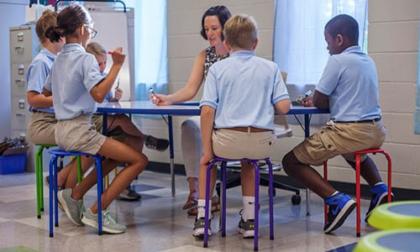There are many things outside of an educator’s sphere of control. Many, many things. However, one thing that I take great pleasure in controlling through smart lesson design is engagement. Gone are the days that teachers can stand and deliver. Children are just not there anymore, and we have to adapt so that we are cultivating a love for learning.
Making Classroom Technology Purposeful: HyperDocs
Now that most schools have technology at each child’s fingertips, I often hear teachers speak on how distracting it can be. Let’s face it-kids are constantly on devices. If the use of technology is not purposeful, it can be distracting in our classrooms. Since tech is such a huge part of the fabric of society today, why not leverage it in really meaningful, carefully planned and exciting ways to enhance our teaching and their learning? Cue HyperDocs.
Blended Classrooms and Developing Student Autonomy
HyperDocs are a great addition to any blended learning classroom. Giving students that ability to have a structured layout of their expectations as teachers meet with small groups, allows for optimal time on task and a great deal of autonomy. Students need to practice what it looks like to not have someone hovering over them telling them every little thing that needs to be done. The sooner we start this, the easier it becomes.
I want to reiterate that explicitly teaching students how they are expected to work through a HyperDoc is imperative. The standard operating procedures that are developed are relied upon by students who might be used to hand holding. They also help prevent any cases of the “I didn’t know”s. When we set kids free to learn with some scaffolds and structures in place, we can spend more time watching them soar.
Structure Collaborative Concepts with HyperDocs
HyperDocs should only be used when the structure of the lesson lends itself to that sort of learning. That constant catch and release through a learning cycle might not be ideal for all types of lessons. A hands on science lab is still the best way to teach certain science topics. However, if you’re teaching a concept that lends itself well to collaboration, creativity, communication and critical thinking, a HyperDoc might be a good way to structure that learning.
Focusing on Engagement as a Lesson Designer: Resources
Back to engagement for a minute. If we are going to be lesson designers, we need to consider creating a learning space that’s fun and inspiring to be in. That means, we should consider how our room is conducive to movement and flexibility. We also must consider lesson design.
One of the authors of the HyperDoc Handbook, Lisa Highfill, has a great YouTube Channel, where she has fantastic tutorials on HyperDoc design. There is also a blog/podcast on how HyperDocs will transform your teaching by Jennifer Gonzalez of The Cult of Pedagogy. I would highly recommend checking it out. Not only is Jennifer Gonzalez fantastic to listen to, she includes all three authors of the HyperDoc Handbook in the episode on HyperDocs.
Check out these resources and give it a go. Moving into this sort of lesson design has been invigorating. I feel like I’m growing and taking risks, and the payoff has been tremendous. My students appreciate this “new way to learn.” They are also learning how to be lovers of learning again.
Want to Learn More About HyperDocs?
If you’re looking to learn more about the potential benefits of using HyperDocs in your classroom, be sure to check out the other related posts on the Schoolyard blog. A 21st Century Learning experience starts with dedicated teachers — use these ideas to get inspired and watch your students grow and learn in new ways.
Read More: HyperDocs, A Tool for Student-Centered Learning
Summer Pettigrew
Summer Pettigrew is a 5th grade math and science teacher at Haut Gap Middle School on Johns Island, SC. With over 5 years of experience in a 1:1 classroom, Summer supports teachers using her expertise with the pedagogy surrounding teaching with technology.








Leave a Reply